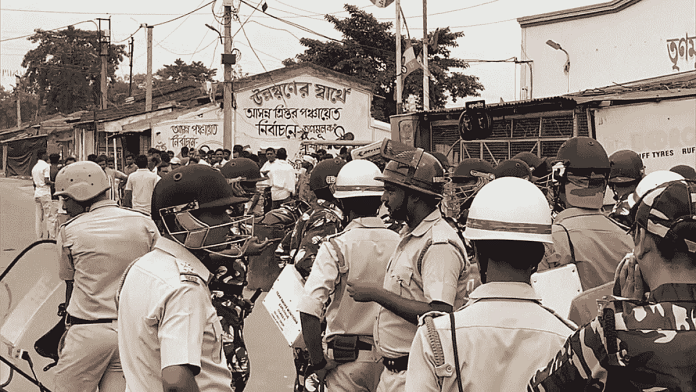Kolkata: Eleven thousand taken into preventive custody, more than 8,000 non-bailable warrants (NBWs) executed and upwards of 20,000 licensed arms seized. These are among the measures taken to ensure that Panchayat polls in West Bengal, to be held on 8 July, are not marred by political violence, as has been the case with local body elections in the state.
On Tuesday, the Calcutta High Court ordered deployment of central forces at all 61,636 polling stations across the state, a day after the Union government, following a high court order, deployed 485 additional companies of central forces in West Bengal — taking the total number of companies deployed in the state for the duration of the Panchayat polls to 822.
According to the West Bengal State Election Commission (SEC), five lives were lost and 337 sustained injuries in incidents attributed to pre-poll violence in the state between 8 and 27 June. Accordingly, the state police took 11,051 persons in preventive custody, executed 8,449 NBWs, seized 20,770 licensed arms, 175 unlicensed arms and 700 explosives, cartridges etc. since the imposition of the Model Code of Conduct (MCC) in the state.
Violent clashes between political workers have remained a common thread in West Bengal under all parties, be it the Congress, the Left or the incumbent Mamata Banerjee-led Trinamool Congress (TMC).
“Violence has been part of West Bengal politics for a long time,” says political analyst Snigdhendu Bhattacharya, adding that the caste and communal violence one sees in other parts of the country have “largely been absent in Bengal where social divisions along political lines have traditionally been a strong factor”.
“Since allocation for panchayats has increased in recent years and the elections are conducted by the SEC, whose independence from the state government remains questionable, grassroots-level politicians have tried to seal the verdict by flexing their muscles,” he tells ThePrint.
Data compiled by the National Crime Records Bureau (NCRB) under the head ‘motive of murder for political reasons’ reportedly shows that West Bengal recorded 13 such killings in 2018 — the highest among all Indian states that year. Minister of State (MoS) for home Nityanand Rai had also informed Parliament in August 2021 that as many as 230 deaths attributed to political violence were recorded across the country between 2017 and 2019.
In the case of West Bengal, a report by New Indian Express suggested that the state witnessed 47 political killings involving BJP and TMC workers since the 2019 Lok Sabha elections, 38 of which occurred in south Bengal.
Addressing the media Monday, Governor C.V. Ananda Bose — who has been visiting parts of the state that witnessed violence in the run-up to the Panchayat polls — said: “This political holi with human blood has to end”. Over the last fortnight, the Governor visited Bhangar, Canning and Basanti in South 24 Parganas, besides Dinhata in Cooch Behar district.
Also Read: Bengal post-poll violence: 70 out of 303 ‘displaced’ people returned home, Mamata govt tells HC
‘Extremist political tradition a hallmark of Bengal’
According to political analysts, the shadow of political violence in West Bengal can be traced to nationalist movements that took shape before India attained Independence.
“Extremist political tradition is a hallmark of Bengal,” says political analyst Udayan Bandyopadhyay. “Even saints like Sri Aurobindo had a violent past… People here do not like soft voices. Bengal does not allow caste-based politics. Even after Independence, religious violence was strongly condemned by the mainstream Bengal politicians,” he tells ThePrint.
Founded in 1902, the Anushilan Samiti — a secret society which launched an armed revolt against the British — is a case in point. Then there were the Calcutta killings of 1946, fuelled by communal frenzy whipped up by Jinnah through his call for ‘direct action’. And in 1967, the state witnessed the Naxalbari movement which aimed to overthrow the state government.
Cut to the 1970s, when the Left began to assert itself by challenging the Congress and what followed was a spate of political violence.
This phenomenon came to a head on 17 March 1970 with the Sainbari murders — when two brothers, both Congress supporters, were killed inside their home in Burdwan in Purba Bardhaman district, allegedly by CPM workers. The following year, the killing of Hemanta Kumar Basu, the then 76-year-old chairman of the All-India Forward Bloc, triggered yet another cycle of political violence.
According to Ambar Ghosh, a fellow at the Observer Research Foundation (ORF) who has studied political violence in West Bengal extensively, control of resources and crucial democratic institutions are the immediate reasons that lead to violent clashes between political workers. He, however, adds that rivalry over allocation of funds earmarked for rural development and the zamindari system, which led to a number of peasant revolts in the state, are among the more complex issues at play in the state.
Asked about the cycle of political violence in West Bengal and the deployment of central forces for the Panchayat polls, Trinamool Congress (TMC) spokesperson Kunal Ghosh tells ThePrint, “Central forces or no central forces, the people of Bengal have faith in the TMC. The law and order system is intact, it is the Left who should not speak about violence.”
In the previous Panchayat polls in 2018, candidates fielded by the TMC had won unopposed in 34 percent of the seats, with opposition parties claiming that their candidates were allegedly coerced to not file their nominations.
CPM leader Bikash Bhattacharya, however, said “there were clashes, but not political clashes”, during 34 years of Left rule. “This was violence due to reforms, like a landless peasant would fight against the landlord. But now what we see is political violence under TMC,” he adds.
(Edited by Amrtansh Arora)
Also Read: ‘500+ calls in 48 hrs’ — inside Bengal governor’s ‘Peace Room’ to monitor panchayat poll violence



